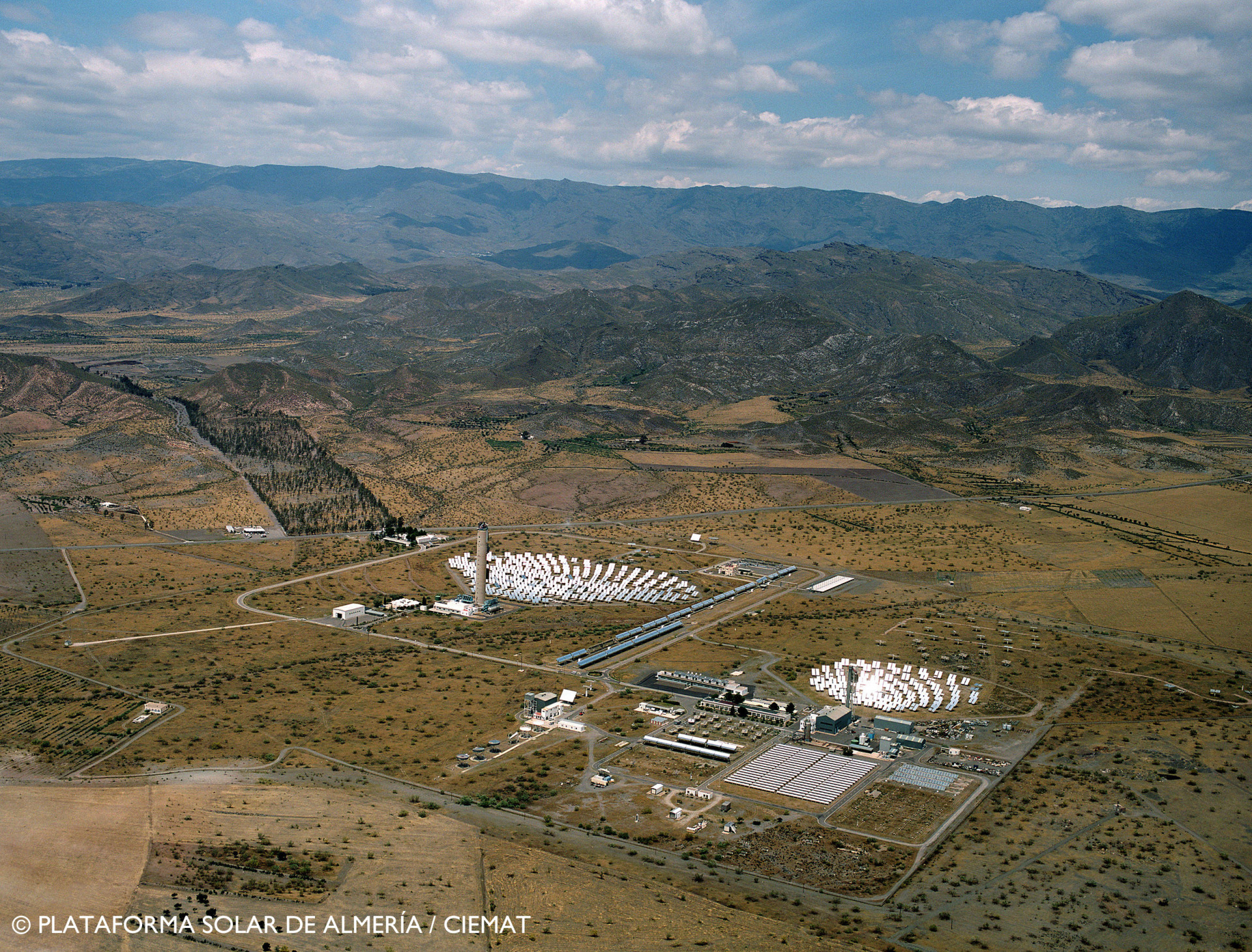 Plataforma Solar de Almería
Plataforma Solar de Almería
Classical optical theory indicates that light rays travelling parallel to the axis of a spherical/parabolic mirror will reflect off the mirror and pass through the focus of the mirror located a distance R/2 from the mirror, where R is the radius of the mirror. The energy of all incident light rays combined at this point, effectively concentrating the light energy. This concentration produces heat, hence the name: concentrated solar power (CSP). So, in short, CSP systems use different mirror/reflector configurations to convert the sun’s energy into high temperature heat. This heat can then be used directly or converted into electricity.
As far as CSP or also Solar Thermal Electricity (STE) generation is concerned, the global (worldwide) installed capacity is currently (mid 2018) close to 5 GW, with another additional 5 GW in current construction/development, being the European CSP industry behind the large majority of all these projects. Therefore, and considering the clear path European society is addressing to the decarbonisation of the energy sector, this technology is called to have a bright future. Certainly, and thanks to the thermal energy storage, CSP/STE can make a significant contribution to the transformation of the European energy system by providing an important share of dispatchable renewable electricity. By providing flexibility for grid services, CSP can facilitate the integration of variable output renewables such as photovoltaic (PV) or wind energy, thereby contributing to the reliability of the transmission grid. The best solar resources for CSP are to be found in Southern Europe, which makes this technology complementary to those renewable energy technologies that find their best resources in other regions of Europe. Besides the generation of electricity, CSP systems can provide high temperature heat for industrial processes or thermochemical processes, thus contributing to the decarbonisation of the industrial and transport sector.
CSP will give a significant contribution to help meet the energy needs of large parts of the world, creating a potentially very important export sector for the European industry and supporting the decarbonisation agenda of the Paris Agreement. According to the forecasts of the International Energy Agency (IEA), CSP could account for up to 11% of the electricity generated worldwide and up to 4% of the electricity generated in Europe by 2050. The market potential worldwide is substantial and this justifies the efforts to maintain the current competitive advantage of the European industry in terms of both installed capacity in Europe and global market share of European companies. Nevertheless, to make all this possible, a strong an intense research effort should be done, being this the main reason behind this JP, as there is still plenty of room for many technical improvements yet, mainly dealing with increasing efficiencies and decreasing costs.
The JP is estructured in the following six Sub-programmes:
- Sub-Programme 1: Line-Focusing CSP systems
- Sub-Programme 2: Point-Focusing CSP systems
- Sub-Programme 3: Thermal Energy Storage
- Sub-Programme 4: Materials for CSP
- Sub-Programme 5: Solar Driven Thermochemical Processes
- Sub-Programme 6: Solar Heat for Industrial Processes and Applications
Some of the partner institutions concentrate the large majority of existing large-scale R&D facilities for CSP in Europe. Most of these facilities are included at the ‘Trans-national Access Activity’ of the EC-funded Integrating Activity called SFERA-III (Solar Facilities for the European Research Area - Third Phase). So, this free access mechanism can be used to ease the way for non-SFERA partners to benefit from them, thus giving a higher coherence to the whole JP.
As a summary, this JP currently involves 15 full participants plus 11 associated participants with a total commitment of 145.40 person-year/year devotion, during the following 4-year project (2018-2021 interval). This JP-CSP JP will continue with the management structure and procedures used during the IRP STAGE-STE and also all current JP organizations (with just one exception) are partners of ECRIA INSHIP so a smooth management of the JP is expected. Finally, this JP-CSP Description of Work (DoW) is designed as a 4-year long project. An assessment of the results and of the partnership evolution will be carried out at the end of such a period in order to decide and define the future subsequent scientific activities and technical content of the JP.